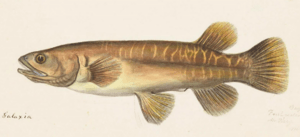Banded kokopu facts for kids
Quick facts for kids Banded kokopu |
|
|---|---|
 |
|
| Banded kokopu | |
| Conservation status | |
| Scientific classification |
The banded kokopu (Galaxias fasciatus) is a special type of fish found only in New Zealand. You can also find them on the Chatham and Stewart/Rakiura islands. These fish usually grow to about 20–25 cm long. Some have even been seen growing up to 30 cm!
Young banded kokopu are amazing climbers. They can climb up waterfalls and other steep, wet places. They do this by wiggling through the wet splash zone. They use the water's stickiness and their big fins to help them grip the surface.
Contents
What Does It Look Like?
Banded kokopu are strong, rounded fish. They have a big head and a large mouth. Like other fish in their family, called galaxiids, their back fin (dorsal fin) and bottom fin (anal fin) are close to their tail fin. Their tail fin is short and square. The part of their body just before the tail is short and thick. It has fleshy parts that connect to the tail fin.
Colors and Patterns
Adult banded kokopu are usually a dark, earthy brown or olive green color. They have pale yellow stripes that go up and down their body. Their belly is light and has no patterns. Behind their gill cover, above their front fin, there is a silver or white mark. Sometimes there's a darker mark behind this.
The stripes on their body either fade away at the top and bottom, or they can split and crisscross over the fish's back. Young fish usually have many stripes all over their body. As they get older, the stripes become narrower. They are often only found on the back third of the fish's body. Even though the stripes change as the fish grows, their shape and where they are placed stay pretty much the same. This means scientists can use the stripes to tell individual fish apart for many years!
How to Tell Them Apart from Other Fish
Sometimes, medium-sized or young giant kokopu can look like banded kokopu. This is because they can also have vertical stripes. But there's an easy way to tell them apart! Banded kokopu have a white or silver mark right behind their gill cover, above their front fin. Giant kokopu do not have this mark.
Also, the stripes on banded kokopu either split and spread across their back, or they fade out. The stripes on giant kokopu never split. They always have a clear, sharp edge all around them. Young shortjaw kokopu might also look like a very pale banded kokopu. But shortjaw kokopu have a very small mouth, which helps you tell them apart.
Where Do They Live?
Banded kokopu are only found in New Zealand. We only know of a few places where they lay their eggs. In 2018, a new place was found in a small river that flows into York Stream in Nelson. This area has been worked on to make it a better home for fish. This was part of a project called Project Maitai.
In Nelson, banded kokopu live in small rivers and streams in low-lying coastal areas. They can also go further inland. There, they hide in pools or under banks that have plants hanging over them.
Life Cycle of the Banded Kokopu
Banded kokopu are what we call diadromous fish. This means they spend the first 3–4 months of their lives in the ocean. After that, they swim back to freshwater as tiny fish called whitebait. They are about 40–45 mm (1.6–1.8 in) long when they return.
Growing Up and Spawning
Banded kokopu become old enough to have babies when they are two or three years old. They lay their eggs in their usual freshwater homes. This happens during floods in autumn and early winter. They lay their eggs, which are about 2 mm (0.079 in) wide, among flooded plants and fallen leaves at the edge of the stream.
When the floodwaters go down, the eggs are left out of the water. But the plants keep them moist, like a humid blanket. After three to four weeks, the baby fish inside the eggs are fully grown. They need another flood to make them hatch! The tiny baby fish are then carried out to sea by the floodwaters. They live in the ocean, feeding on tiny ocean creatures, for 3–4 months before swimming back to freshwater.
Finding Their Way Home
Young banded kokopu can smell things that adult banded kokopu produce. This suggests they can recognize special smells from their own species. These smells might help the young fish find good places to live, by telling them where other adults are.
Banded kokopu can live for at least nine years. They might even live longer! They can also lay eggs many times during their lives.
How They Behave
Banded kokopu are mostly active at night. You can watch them easily at night, especially if you use a red light. You can also see them during the day if they are not disturbed.
Young banded kokopu are one of five types of galaxiid fish that are caught and eaten as whitebait.



